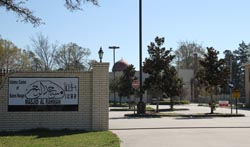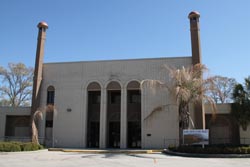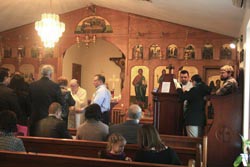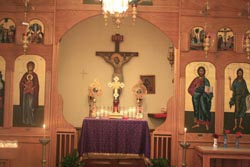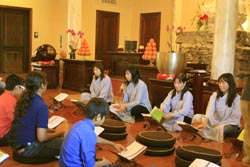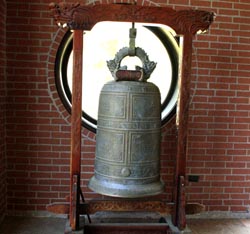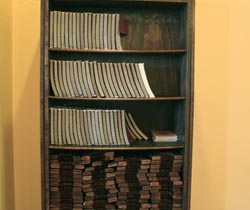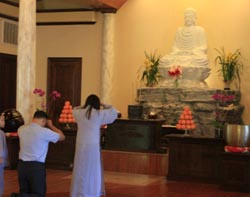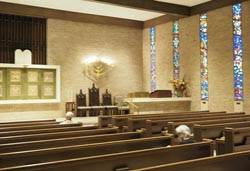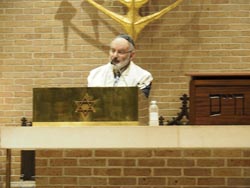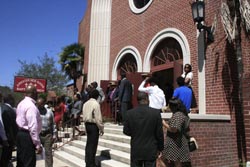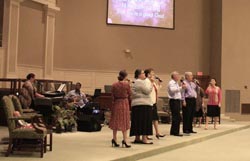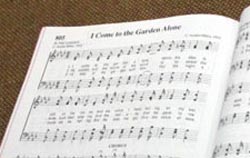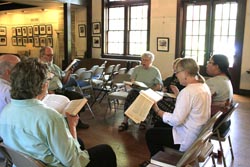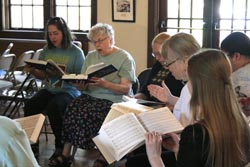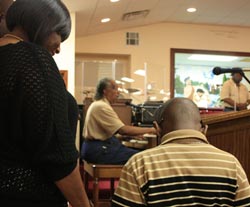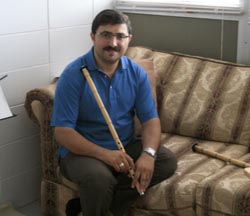Sacred Sounds in Baton Rouge Churches, Synagogues, Temples, and Mosques
By Maureen Loughran
We do it from the heart to edify God's holy name. . . . We all enjoy and do it from the heart, not for fashion or show.
—Joseph Anthony, Greater St.
James Men Singers, Baton Rouge, La.
Baton Rouge is typical of many cities of the South, in that church, irrespective of denomination, is an important facet of everyday life, especially on Sundays. There can be found churches dedicated to Christian faiths, whether that be Baptist, Presbyterian, Catholic or Orthodox. Synagogues, mosques and Buddhist temples also provide spiritual guidance to the population of the Capital City. This fieldwork project was an attempt to document sacred music traditions in Baton Rouge, and particularly the song leaders or music directors at various religious institutions. The project also developed a focus on chanted religious expressions (whether considered musical by the denomination or not), from Greek Orthodox chant to recitation of the Qur'an. The following essay explores the different ways in which religious institutions in Baton Rouge support musical traditions within their organizations, including religious denominations less dominant in the Southern spiritual landscape.
Chanters and Reciters: Islamic, Orthodox and Buddhist Traditions in Baton Rouge
The most basic form of ritual can be found in the recitation of religious texts. In some communities, this recitation is expressed musically through chant. In others, like Islamic cultures, music is a secular endeavor and therefore not an appropriate term for describing the rendering of holy words into speech. In Baton Rouge, you can find various approaches to the recitation of sacred texts in Christian churches, Jewish synagogues, Buddhist temples and Muslim mosques.
Qur'an Recitation
At the Masjid Al-Rahman campus of the Islamic Center of Baton Rouge, the recitation of the Qur'an is a central facet of the education of their youngest members. Each Saturday, the mosque holds a Qur'an and Taribiya School for children as young as pre-school age. Taribiya School involves the teaching of manners and values, while in the Qur'an recitation class, students learn not only how to recite the Qur'an but also spend time discussing the text they are reciting. Dr. Ömer Soyal, an assistant professor of computer science at Louisiana State University, directs the school to address both manners and religious recitation because as he says, "Islam is all about the true belief and the good manners. It's the complete package" (Soysal 2016). And while recitation may imply that the material is to be memorized, Dr. Soysal insists that the goal is instead to provide understanding. By learning how to recite the text, the student begins to uncover the meaning of the text. Memorization aids in understanding and provides a structure to practice of religious faith in everyday life.
A visit to the school at Masjid Al-Rahman is reminiscent of any after-school program you might find at a community center or church hall. Parents drop off children, varying in ages from pre-school to middle-school, who pile into the all-purpose room, finding friends and digging through lunch boxes before gathering into lines for their classes. The student recite a prayer in both Arabic and English affirming "I am a Muslim." Then, they move to their respective classrooms where they learn different aspects of Islamic traditions. In one of the middle school classrooms, the students sit at two tables, girls on one side, boys on the other. The class is led by Dr. Soysal's son, Hanif, who is a student at LSU. That day, the class was learning the 104 surah or verse of the Qur'an. Hanif started the lesson by reciting part of the verse, which the students would repeat, step by step until the entire surah had been recited in Arabic. If the students were confused by the text or having trouble with pronunciation, Hanif would say the verse with deliberate emphasis, slowly speaking the text with the student. Once they had confidence with speaking, the students would listen to Hanif recite the verse with melodic emphasis and they would repeat.
Dr. Soysal reminds us that while recitation may sound like it has a melodic element to it, the recitation of the Qur'an is not considered to be a musical event. In fact, there is a clear division between the music as secular and recitation as sacred. He explains:
We avoid music traditionally because of the way it is used. Abused, actually we'd say. But definitely there is a rhythm in the Qur'an that effects the heart actually. Because if you listen to a reciter, from reciter to reciter you will see the difference, the effect on your heart. . . . Really, the Qur'an has its own type of rhythm. Especially rhythm that touches the heart. (Soysal 2016)
Suleiman Suleiman, a graduate student at LSU and a native of Saudi Arabia, is considered by Dr. Soysal to be one of the best reciters of the Qur'an in Baton Rouge currently. Suleiman grew up in Medina, one of the most holy cities in Saudi Arabia, and home to many students of the Qur'an and their teachers, known as sheiks. Suleiman's father was one of these teachers, and Suleiman began studying with his father at a very young age. Suleiman explained the process:
I started with a little bit each day, but it had to be every day. So every day with my father I would sit for two or three hours in the afternoon and he would, like, teach me the small verses, small surahs. Once I went into first grade, . . . I had a schedule every day. So in the morning I would go to school, and then come back in the afternoon and rest a little bit and then around this time or even before that, 4:00 pm every day I would go to a nearby school. So I went through stages sometimes for several years I used to go to a school that was only for Qur'an. It was an evening school, an everyday evening school. They would only teach Qur'an there. Like it was a huge school, twenty classrooms, 20 sheiks, and each sheik had about 20 students. So I was part of those classes for about six or seven years. For those six or seven years, I memorized about half of the Qur'an or a little bit less. (Soysal 2016)
Suleiman eventually was able to memorize the entire Qur'an by the age of 13. For him, the fact that the text was already in his native language, helped him to memorize the text. For the children learning to recite the Qur'an in Baton Rouge, they have a new language they need to conquer as well as trying to memorize a complex and long text. Their teacher, Hanif Soysal, stressed the importance of knowing what it is that you are memorizing. "I'm not a hafiz, someone who has memorized the entire Qur'an, by far," said Hanif. "But for me, when memorizing, I memorize specifically. . . . I'm not going in any specific order, but I like to memorize those verses that spiritually mean more to me. And because they do that and because I know that they mean, it's much easier to have them memorized. It's helpful." (Soyal 2016)
Another teacher at the Masjid Al-Rahman, Nafes Hakim-Khiry Furqan is an American raised in the Islamic tradition. He echoed much of the opinions of Hanif and Suleiman about learning how to recite and then memorize the Qur'an. In our conversation, Nafes reminded us that learning to recite the Qur'an is not just for the sake of learning the text. The recitations have a specific role during one of the most important moments of the Islamic year. As Nafes comments:
We're encouraged throughout the year to recite from the Qur'an so that we won't forget it. Or so that we won't . . . our skills won't deteriorate. And it's like with anything. If a singer doesn't sing for a while, they have to take more time to rehearse before they do it. . . . If you stay out for a while, you'll have to take a long time to warm up before you are good at it. So anything that involves recitation memory, muscle memory. It's encouraged to practice that throughout your life. Even if it's just thirty minutes a day, so that you won't forget it or get worse at it. But we do have a set time of the year when it's really important, we get out as much as I can, as much as we can and that's during Ramadan. The month where we fast.
Ramadan is the holy month in the Islamic calendar which celebrates when the Qur'an was first revealed to the Prophet Mohammed. During the month of Ramadan, followers fast during the day for thirty days, and break the fast at the end of the month with a celebratory feast called Eid al-Fitr. Not only is the Qur'an essential to the celebration of Ramadan, its structure reflects its use during the month. The Qur'an is divided into 30 sections, called juz'. These 30 juz' allow for the Qur'an to be recited daily within a month's time. According to Dr. Soysal, Ramadan is a time of training the self, and practicing the recitation of the Qur'an aids in this training. He adds:
But on the other hand, Qur'an itself, we call it the shifa, healing for hearts. It heals the hearts. We cannot say that it heals like medicine, it heals your spirit. That's why Ramadan also when we increase the reading the Qur'an the way it is supposed to be heals our spirit. Also so we learn how to control ourselves and we heal ourselves. We take care of ourselves spiritually reciting the Qur'an. (Soysal 2016)
Greek Orthodox Chant
In the Greek Orthodox community, recitation of holy texts and prayers takes on more musical connotations in their liturgies. The Holy Trinity Greek Orthodox Church in Baton Rouge is very small, but they have a devoted and active community of congregants. On a typical Sunday, two or three chanters are at the front of the church near the altar leading the service and the congregation in what sounds like ancient prayers. And as Father Anthony Monteleone, the leader of the church, commented, the chants are ancient in both their texts and their melodies:
In Orthodox spirituality and tradition, the liturgy is literally making heaven present on earth. It is literally the union of heaven and earth. And what plays a very important part in this experience is the chant. . . . Music, chant, on one hand, it transforms prayer. It transform prayer into song, and that song transports us from earth into heaven or heaven unto earth. With Orthodox being mystical and practical, once it's over, you go out and do what you got to do. But you carry that song in your heart which has been chanted as we hear it with roots two thousand years old. (Monteleone 2016)
Because chant is so central to the liturgy, the Greek Orthodox calendar is even shaped by chant. Each week of the liturgical year is marked with a tone, which is the initial tone for all the chants in the liturgy that week. During specific liturgical seasons, such as Lent, the tone's sound will reflect the mood and meaning of the season. There are eight tones in total which are cycled in succession through the year. Father Anthony related the tones to the ancient Greek tones described by Plato in the Republic. These tones can evoke a different mood and express or underline meanings found in the texts being chanted. In total, the tones and the liturgy all revolve around the Easter liturgy and the theme of Resurrection, which Father Anthony described as "the liturgy of all liturgies." He explained by reading a hymn that would be recited in the Fourth Tone:
The content, the meaning in English. 'The joyful news of your resurrection was told to the women and disciples of the Lord by the angel. Having thrown off the ancestral curse and boastingly told the apostles, Death has been vanquished. Christ our God has risen, bringing to the world great mercy.' You have in this hymn, in a nutshell, Eastern Christian Greek Orthodox worship. Because at the heart of our worship is the celebration of the Resurrection. . . . So consequently, the traditions in the Eastern Orthodox Church in the liturgy itself every Sunday, emphasize, emphasize, emphasize the joy and even the triumph in the joy of the Resurrection. Not only in the world to come, but in the world now. . . . This is the hymn sung in Greek in the fourth tone. And you may note it should indicate a mixture of joy and triumph together, which is Resurrection. (Monteleone 2016)
On a recent Sunday at Holy Trinity, a group of three chanters led the congregation in celebrating, Orthodox Sunday, the first Sunday of Lent in the Orthodox calendar. The chanters sang for almost the entire two hour service. Their role is to lead the congregation in the singing of the liturgy, chanting the prayers, litanies, and responsorial hymns. As Jaycob Warful, a chanter at Holy Trinity noted:
There's really nothing that we sing that is off-limits for the congregation to sing and ideally we could have as many people singing as possible. It's been estimated in many different places that the liturgy is made up of 4/5ths of hymns. And all of those hymns should be sung by the entire congregation. But all of those hymns, as we are discussing with the litanies, the responses, those things are very repetitive specifically to encourage more people to engage because the more familiar they are with them, the more likely they are to engage. (Lacraru and Warful 2016)
There are hymns or special songs that the chanters will chant during some liturgies, and during these times, the chanters are usually the sole singers, only because the congregation may be less familiar with the hymns being lead. Noticeable during many hymns is the way in which the chanters sing. One chanter may take the melody line, which the congregation may also sing, while another chanter will sound a drone note underneath. This drone note, called the ison, is sung by the lead chanter and helps to keep the congregation and the other chanters within the range of the musical mode for the chant.
When asked how the chanters learn to sing, the answers reflect the nature of life as a musician in a small community, and in the age of technology. Most members of the congregation at Holy Trinity have grown up with the tradition, and as Father Anthony observed, "if you want to know what the faith is of the Orthodox Church, apart from the scriptures and the New Testament, you don't have to study great books of theology. You just have to study and know the chants." (Monteleone 2016). Both Emma Lacraru and Jaycob, chanters at Holy Trinity, grew up within Orthodox communities and learned through attending services. Other resources include seminars and workshops taught by the Archdiocese in Atlanta, and online essays on the Archdiocese's website. Emma noted that in her native Romania, the conservatory where she studied even had a special section where musicians could specialize in Byzantine music in all its complexity.
Each Greek Orthodox Church also has a special hymn that is attached to that particular church. It is sung at nearly every liturgy, and will relate to the name of the church, whether that is a saint's name, or Patriarch or one of the three holy hierarchs. For Holy Trinity, their song is a hymn of Pentecost. And while chant is essentially meant to be a congregational hymn, the role of the chanters is still an important position within the service, as Jaycob pointed out:
Most of the service is composed of the hymns, so the chanter is going to be the primary individual responsible for doing that, and historically it's been an office that people are appointed to and ordained to, almost the lowest level of ordination through which individuals would go who were rising up through the ranks by their chanter and then maybe deacon, then priest and so for. So it is a very important position because it really keeps the rest of the congregation on track, as I has said, with the part that they meant to play. Once again, reiterating that ideally everyone would be singing but the chanter is the one who is meant to lead them in that singing, so yes, it's very important. (Lacraru and Warful 2016)
The appointing of chanters in this small church is done by recruiting strong singers from the congregation. That is how it happened for both Jaycob and Emma. An elder chanter at Holy Trinity heard Jaycob singing in the pews, and asked him to join the chanters. In turn, Jaycob recruited Emma to chant because of her strong musical background. By leading the congregation in prayer, chanters in the Greek Orthodox Church celebrate and nurture a tradition that is thousands of years old, as well as help to build a new and growing community here.
Vietnamese Buddhist Chant
Another community with an equally ancient tradition of chant is the Vietnamese Buddhist community in Baton Rouge. Like with the Greek Orthodox Church, the Buddhist traditional liturgy involves an almost seamless flow of chant throughout the service. The congregation participates in the service by chanting, bowing, praying silently, and listening attentively to the priest during the Dharma talk. In Baton Rouge, a large community of Vietnamese Buddhist worshipers attend the Tam Bo Meditation Temple, where the practice is focused on a Zen Buddhist tradition. While the majority of those who attend the temple are Vietnamese, there are also many Westerners who are able to follow the liturgy through the aid of translation via wireless headphones. Another member of the congregation simultaneously translates the service for those without the Vietnamese language.
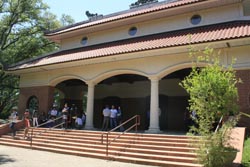
The temple is located within a large compound, beautifully landscaped with flowering plants and trees, and situated alongside a courtyard shaded by large live oak trees, from which hang large metal wind chimes. After a Sunday service, the congregation gathers in the courtyard to eat a vegetarian lunch and visit with the monks at the temple. The atmosphere on a Sunday is warm and welcoming. The congregation, also known as the sanga, meets at various times in smaller groups throughout the week, but just like other religious institutions in Baton Rouge, Sunday morning is dedicated to the largest gathering of those who attend the temple each week.
Before the service, members will slowly take their place on the floor, sitting on a round cushion and placed before them, a wooden book holder on which are two books containing the chants, songs and order of service for the temple. The liturgy begins with the ringing of a large bell right outside the door to the temple, alerting stragglers that the service is soon to start. A group of chanters, dressed in grey robes, sit at the front of the temple facing the congregation, and begin a series of chants. The title and page number of the chant is announced, usually in Vietnamese and sometimes in English, and the congregation is encouraged to sing along.
Behind the chanters is the altar space where the Abbot sits, and behind the abbot is a large stone statue of the Buddha. On either side of the altar are two instruments that are played by a designated chanter at specific times during the service. One is a large brass bowl, the chong gia tri that acts like a bell and is both struck and dampened on its rim. It is used to highlight specific moments when the congregation changes to a new chant or shifts to a new part of the ceremony. The second instrument used in the service is a large wooden drum, which is shaped like a fish. One of the chanters will use a large mallet to strike the drum on its dome-like top, usually during the recitation of sutras. The drum is used in a portion of the service when chanting takes on a very deliberate speed, with the drum inciting a faster rhythm to the chant. Before the service begins, however, the speed is slower, and the chants are each led by different members of the chanting group facing the congregation.
Thich Dao Quang, the Abbot of the Tam Bao Temple, explained that the service structure for a typical Sunday as such:
Usually, this is our life, the structure of the Sunday service. I start at 11:30 am Louisiana time. I like to be on time, by inviting the whole sanga, the whole community to sit down and quiet their mind within 10 minutes. And then stand up, we prostration three times. We show love and respect to the Buddha, Dharma and Sanga. Buddha the founder of Buddhism. Dharma, his teaching, teaching of love and compassion. And Sanga, the community in which everyone practice living in peace and happiness. Then, depends, for example, beginning a new service or repentance service, so the chanting is emphasizing about everyone makes mistakes but then everyone has potential to learn lessons from his or her mistakes and move on and make their life better, . . . And also following fifteen minutes chanting maximum, then I prepare a short lesson or sermon you call, or dharma talk within 40 minutes. And the themes of every Sunday depends on what's going on. It's not about what I like to teach but what's going on in the community. And I think that is the most appropriate topic for the community. For example, on this Sunday, I have a thought to offer for the dharma talk, "How to transform the negative karma into positive karma." And following the service, after the dharma talk, people stay together, enjoy the community lunch and do the community work. I see that this is the best way to enrich the brotherhood and sisterhood of the community. So that is the typical service on Sunday. (Quang 2016)
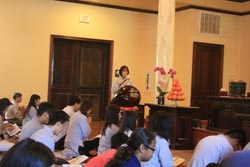
As the Abbot explains, the chanting during the service has a direct connection to the topic of that day's lesson and also to the general teachings of Buddhism. The basis of the chanting comes from different main texts within the religion, which are called sutras. These are the teachings of the Buddha and are chanted during specific times within the service. The sutras are known by names like the Heart sutra, the Lotus sutra, and the Diamond sutra. For the Abbot, he chooses a sutra for the service that will fit with the main theme he will be reflecting upon during the service. Another chant present in the service are mantras, which are short sequences of chant that are recited to encourage meditation. Mindfulness is an important part of the practice and chanting is used as a tool for gaining "bright attention." The Abbot, in particular, mentioned that there is a structure to chant which aids in the attainment of mindfulness. Quang explained it this way:
Phase One, or Part One, you may say that, you're accepting your weaknesses. Second part, this is understanding the weaknesses, if you're not transformed, create more weaknesses in your life, in the community, in the society. So the second part is promises to transform your negative behavior, actions and so forth. The third part is that you believe in yourself. That you have a self confidence that you can do it. You can transform it and then you promise you can contribute back and help the community. That's the powers in all the chanting here I pick. And sometimes I emphasize on the concept of compassion, so all the chanting is become compassion with yourself, compassion with the others, and compassion with all things in your life so that you can get more benefit and also create the good merit.
Chant also has a function outside of the temple service, especially as it is used as a tool for creating good merit. Brother Fred Van, a young monk at the Temple, explained that chanting gives you positive energy and helps you keep mindful in situations outside the temple walls. The important focus is not on memorizing words and reciting them in a mechanical way, but instead a focus on the meaning of the words will bring centeredness and reflection to aid in any situation. As Brother Fred shared:
When you chant with your whole heart, just like singing a song and you understand what the music means and you put your whole heart into it, and the meaning of what you are chanting, like what I just went through, invoking the name of Buddha. If you understand when you are chanting deeply and are full of peace, full of love and full of energy, it brings, it nourish the wholesomeness, that good seed in yourself. It's like, yes I have the ability and today I'm going to conduct my life in that way. It's just a reminder. And when we are going through difficulties in our life, those chants, those evoking certain mantras or certain gathas, it helps remind us, "Ok, let's come back to my breathing. Let's come to my understanding and have compassion for this person." And we do that daily, just like music. If you could just sing that one song that connects with you and awakens you in that moment. (Van 2016)
While the chant helps to awaken the chanter through the words of the chant, the language of the chant can be an impediment, not only in the style of the language but also the terminology. At the Tam Bao Meditation Temple, Modern Vietnamese is the main language used by the sanga. However, many of the original religious texts, the mantras and the gathas (verses used to help breathing in meditation), used more ancient forms of the language. According to the Abbot, these ancient languages are an impediment to understanding for a modern congregation. But the adaptations he makes in the texts not only focus on the language, but also on the content. He shared an example of Buddhist monks who cited the holy River Ganges in India as a specific symbol. The Abbot felt that the resonance of the example would be lost with such a foreign and unknown river used as the important metaphor. His solution was to make the example closer to home, "But how many people here know about the Ganges River? So I just say Mississippi River--that is the language I may prefer." By making these kind of adaptations, the tradition is allowed to continue with resonances that connect the congregation to the lived reality of their everyday lives.
Chanting takes place within other services at the temple, including a special gathering that is called the Forty-Nine day service. At Tam Bao temple, this service is celebrated 49 days following the death of a member of the congregation. That member's family will request the service in order to show respect and love to the spirit of their loved one in the wake of their passing. Quang considers the Forty-Nine day service to be a important part of the grieving process and a way to "transform negative emotions." The family, along with the monks, will meet at a section of the temple dedicated to the ancestors, prior to the Sunday service. The service includes a short period of chanting, during which time the family reflects on their deceased family member. Then, the family will join the sanga for the usual Sunday service, which, in a way, allows them to knit themselves back into the fabric of the congregation. Again, the chant in the different services acts as prayer and the prayer brings attention and mindfulness both to the individual and the community.
In all of these conversations about chant and recitation, the use of the term "music" seemed a clumsy way to talk about sacred language and sacred sounds. In Islamic tradition, there is a complete division between music and recitation. Music is secular, while recitation is sacred. There are musical elements in recitation, but these elements are not conceived of as musical by those who recite. Likewise, in the Buddhist tradition, musical elements are part of the experience of chanting, but chant is not considered to be music. The Abbot at Tam Bao temple reflected on the issue:
When we borrow the language, when we say chanting, different people come from different culture, background, they may have a different perception. But from my personal experience, I can see that chanting is the spiritual food. We need it. Even I practice by myself. I feel that I have a more positive energy after I practice seated meditation and short chanting in the morning. [It] promotes me, motivates me to overcome all obstacles in life. It motivates me to continue my dissertation research! So for me, if you truly understand the language of chanting, that's the powerful spiritual tool you should carry even when you stuck in traffic. Instead of worry, [it is a] great opportunity to chant.
Songleaders: Jewish and Christian Traditions in Baton Rouge
In many congregations, the musical direction is the responsibility of one person, who may sing with the choir, sing as a soloist, play the organ or simply lead congregational singing. Much of their job depends on the kind of music the church or temple uses, and even the role and function of that music in the service.
The Cantor
On a Friday evening in late January, the B'nai Israel congregation gathered for its twice monthly Union Prayer Book Sabbath service. This is one of the most traditional services at this Reform temple. At this particular gathering, children ran up and down the center aisle and played tag among the pews as the members slowly found their desired seats and chatted with the Rabbi. The service began with a blessing and the lighting of the Shabbat candles, which that night was done by the grandmother of many of the children present. That evening, before the service proper, the Rabbi conducted a baby naming ceremony, during which one of the grandchildren would be receiving his Hebrew name. After the ceremony, the Sabbath service began, with the sound of a large pipe organ and the operatic baritone of the cantor leading the congregation in song.
The cantor at this synagogue is Dr. Stephen Rushing. Dr. Rushing is also a professor of music who teaches voice at Southeastern University in Hammond, and he is the music director at First Presbyterian Church in Baton Rouge. While Dr. Rushing did not grow up in the Jewish tradition, he has a lot of experience singing for Jewish services. His experience as a song leader, however, started in the Catholic Church, the church in which he was raised. Singers are usually in high demand as leaders for church services, and in some denominations, it is not mandatory that the song leader be a practitioner of the particular faith they are serving. Dr. Rushing has worked in Catholic, Methodist, Congregational, Presbyterian and Jewish congregations, among others. His first experience singing in a Jewish temple was while he studied voice at LSU and was asked to substitute for the usual singer. He had what he called "a crash course in Hebrew pronunciation," and took the gig. Then in later years, while living in Des Moines, Iowa, he was hired as a member of the chorus for the celebration of High Holy Days at a synagogue there. His experience participating in these services added to his understanding of how to be a cantor in later years. As he commented:
A lot of it was just by learning on the fly and getting to know the words and the music and learning the translations over the years. There aren't really any programs to train non-Jewish singers in the tradition of cantor or even a choir member. If you're lucky, you're in a large congregation, if you're living in Milwaukee or somewhere like that, . . . But in towns like this, where the communities are smaller, they rely on those artists and musicians who are local to help support their worship service. So they hire people like me. (Rushing 2016)
Dr. Rushing has spent many years working as a Cantor at B'nai Israel, and during that time has gained a deep interest and appreciation for the music of the Union Prayer Book service, as well as other services at which he's been asked to sing. He cites the great cantors of New York from the early to mid-20th century as particular inspirations. Some of these cantors, namely Richard Tucker and Jan Pierce, were known not only as cantors within their communities, but also as opera singers on the world stage. Their vocal technique and classical training could serve both venues. And as a result, several important pieces used within the Jewish Sabbath service have been set to music by important classical composers like Maurice Ravel. For the service on Friday evenings, however, the music used is more standard and follows one of five different services set in the Union Prayer Book. The Rabbi choses which service will be followed on a certain Sabbath, with some rabbis alternating services from week to week, and others choosing to use the same service for each meeting. Dr. Rushing feels that having the same service week to week instills a sense of security among the congregation, a comfort in knowing moment to moment what is happening. For him, "it's a moment of catharsis when I go there and my shoulders go down, my breath lowers and it's a great way to sing and a great way to be relaxed in the presence of God."
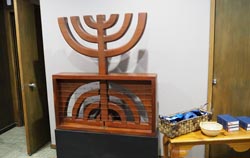
One piece in particular that Dr. Rushing really enjoys singing is the Kol Nidre, which is the opening prayer of Yom Kipper, the Day of Atonement and the holiest day in the Jewish calendar. He told a story about why it is sounded three times, at least according to a rabbi he was working with once:
A very beautiful prayer. The tradition is, it's still a tradition at this synagogue, it's that the Kol Nidre is iterated three times at the beginning of that service. You hear it three times in a row. In our congregation, you hear it played by the cello once. They speak it entirely and then the cantor sings it. Then one day I said, "Rabbi, what's the deal? Why do we say this three times? It's not biblical." I was making a joke. He told us that this was such an important prayer in Jewish tradition that the rabbis wanted to make sure that people heard it. So they had a problem. People didn't show up to service on time. So what they did is that they repeated it three times! To make sure that everybody got to hear it. I said, "You're kidding!" and he said, "No!" So you never know what's going to affect performance practice. . . . But this particular prayer was one that they absolutely [felt] was necessary that everybody heard it. So sometimes you'll hear it spoken three times or sung three times, depending on what the options are. But that's another really wonderful prayer. That's actually mostly in Aramaic but also some in Hebrew it's sung. (Rushing 2016)
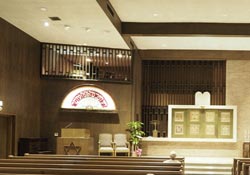
The placement of the cantor, or where the cantor sings, can also be determined by the Rabbi. At B'nai Israel, the cantor sings from a choir loft that is above and to the left of the bima, or the altar platform from where the rabbi addresses the congregation. This is a small space which is slightly screened-off, and barely contains the large organ in addition to the cantor. When sitting in the pews below, the sound of the cantor can seem otherworldly, as if a voice is coming from above, since it is difficult to see either the cantor or the organist. There are other times when Dr. Rushing has sung from the bima, in view of the congregation and sharing the lectern with the rabbi. The fact that Dr. Rushing is not Jewish and yet is the Cantor at B'nai Israel is not completely unusual, but it does present problems when trying to learn the work of cantor in more traditional institutional settings. Traditionally, the cantor would be trained in the same religious training as a rabbi, and would essentially be ordained a rabbi. Because of this, it is preferable for institutions that train cantors that their students be members of the Jewish faith. At B'nai Israel, Dr. Rushing took over cantorial duties in 2007 after spending several years as a hired soloist and member of the choir hired for the High Holy Days. The learning curve was intense as he had a lot of new music to learn and sing. Rabbi Barry Weinstein, the rabbi at the time, saw this and thought a summer course at Hebrew Union College in Cincinnati would help the new cantor get up to speed. Dr. Rushing explained what happened:
So I called Hebrew Union College the semester before and I explained who I was, and they kept asking me questions. "Are you the choir director?" I said, "No, I'm not the choir director." "Are you the organist?" "No, I'm not the organist." "Well, what do you do exactly?" "Well," I said, "Well I'm the cantorial soloist." And they said "Oh." They said, "Well, I hate to tell you but we don't allow non cantors or people who are not studying to be a cantor to come to our workshops. If you were a choir director or you were an organist, and you were not Jewish, it would be ok for you to come and take a workshop from us. Because what we do here is we train people to be cantors, we don't feel as though we should be training people who are not going to or opening this up to them." And I respected that. I mean, I questioned it first of all, just because that's what I would have done. I would have probably said, "No that's not the right thing." Because it is, I mean everything that a Rabbi can do a cantor can do. They are a Rabbi. They can just happen to have these extra skills in music. So, instead of me going to Union College, I actually went down to New Orleans and coached with Joel Coleman, Rabbi Joel Coleman, from one of the synagogues down there. That's when I really started to understand better the context of the music, what roles it played, the importance of certain moments. (Rushing 2016)
Baptist Church Music Director
Being a song leader involves singing, but it can also involve guiding the direction of music overall at the religious institution. That can mean not only choosing music to sing, but directing the choirs, coaching the musicians and leading the musical expression of worship for a congregation. At Greater New Guide Baptist Church, Antonio Rice, plays all the roles of a church music director: running rehearsals, choosing music, singing as a soloist, meeting with the Pastor and many other tasks. On a typical Sunday at the church, you will find Antonio leading both the choir and the congregation.
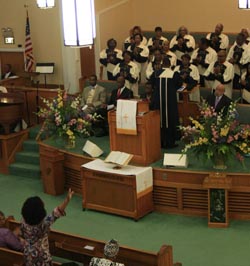
The repertoire at Greater New Guide places an emphasis on traditional Baptist congregational hymns, with occasional modern gospel choir songs interspersed throughout the service. These hymns are considered central to the mission of Greater New Guide, and are sung in a very deliberate and unison style. Pastor Isaiah Webster, the pastor for Greater New Guide, feels that congregational music is the best kind of music for his church because it removes the impulse for performance as entertainment and competition. But he also understands the value and history of choirs in the Black church tradition. He shared, "For several years, we didn't have a choir. We had congregational music. So that tells you how strongly I feel about that. . . . They talk about the Levities in the Old Testament, but think the choir as we understand it is kind of hard to find in the Bible!" (Webster 2016). Still, Pastor Webster felt that it was important to acknowledge that his congregation was interested in having a choir and he has made sure to keep a balance between the importance he places on hymn singing and the interests of his church in other styles of singing. Antonio himself commented that this hymn tradition was not one that he was familiar with from his own experience growing up in the church:
Greater New Guide sings hymns from the first stanza all the way to the last stanza. And maybe at home we'd sing the first verse and the chorus and repeat the chorus because we don't know the next verse. But . . . when I got here I was amazed because, actually the hymns tells a story, so if you leave a verse out, you're missing part of the story! So it makes sense to sing the whole story.
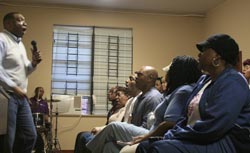
Antonio grew up in a small town in Northeast Mississippi, where his parents were both active members of different churches. His mother's church was similar to Greater New Guide in that they sang hymns, but his father's church, which he called his home church, was one that featured quartet singing. He and his sister used to "play church" at home as kids, where she would wear a choir robe as if she were a member of the choir and he would construct an imaginary piano out of a coffee table, with clothespins on the floor as piano pedals. He admired the pianists he heard in church and was particularly inspired by his piano teacher, Doris Cleveland, who played a more traditional style of music. Antonio was also influenced by the gospel music he heard on the radio. Listening to these radio programs, he became inspired to become a choir director, getting his first church pianist job in seventh grade. He played in a variety of churches, from Methodist to Baptist churches in and around Macon, Mississippi. Antonio learned on the job, by watching other choir directors, and through gospel music workshops. In college, he continued his music studies in choral music and gathered all of these experiences into how he approaches his current job as the music director at Greater New Guide.
The relationship between the pastor and the music director at Greater New Guide is one that guides the choice of music at the church. Antonio works in tandem with Pastor Webster, to shape the musical themes for each week. He explained the process like this:
It's enough for him [Pastor Webster] to give me this sheet, and he gives me the text where he's coming from and I read the text and I get a good understanding of the text and then I can select the song from there. Let me tell you something, if the spirit would give me songs before he gives me the text . . . like right now I don't have the music for the next quarter yet, but I'm already compiling songs because I kinda feel like I already know what direction he's going in. From where he's preaching from now, so. And sometimes I'll make the song lists without even looking at his sermons and [Snaps] it rolls just like that. I try to stay in tune with the spirit so I can know what I need to be ministering on Sunday. Sometimes we have to minister directly to people. Well, all the time we're ministering directly to people but sometimes there's something specific that the person needs and God will give me a song to minister to that person. Just like writing a sermon. Just like in a sermon, you have to have the right song for the right moment. (Rice 2016)
Antonio's approach to choosing songs is also influenced by the sense of continuity that he aims to achieve with the music during the service, or the sense of flow. As a music director, he is not only responsible for leading the musicians, but leading the congregation in worship through music. Flow is achieved when the music connects the congregation to the spirit of worship thereby unifying the church in their celebration. According to Antonio, the musicians have as much responsibility for the state of flow as he does:
The point is to keep everybody together and eliminate all distractions. If it gets quiet in church, it's easy to have a distraction going on. But if everybody is tuned to what's going on in front of them, then you can kind of keep everything together. Now, if the flow get off, it's going to be kind of up to the musicians to get the flow back on. Because the musicians are the ones that are actually working during the worship service. They've actually carried the worship service up until the point when it's time for the word of God to come forth. So, their responsibility in worship service is just as important as my responsibility as the choir director in worship service.
The importance of keeping the spirit moving in the right direction becomes one of the most important roles for a music director. And it is a theme that returns in other faith denominations, the efficacy of music in directing not only the congregation, but the spirit.
Worship Leaders in the Pentecostal Church
The First Pentecostal Church of Baton Rouge's repertoire is decidedly modern and current with popular music trends. But it is music that has for its main purpose the same function as old-time hymns: leading the congregation in praise and worship. On a recent Sunday, the Praise Team gathered to rehearse the songs for that day's service. A drummer, bassist, and keyboardist were in full rehearsal as the Praise Team members gradually arrived under threat of a massive thunderstorm. It was 8:30 am, and the service did not start until 11am, but there were several pieces to go through and then Sunday School to attend in-between, which meant rehearsal had to go smoothly. The vocalists each had their own wireless microphone and sang the songs, in parts, from memory. Their leader, Deidre Summers, played keyboards behind them, stopping the group every once and a while to review a harmony part, or discuss the sequence of the lyrics displayed by the overhead projector. After an hour of rehearsal, the musicians went to their Sunday School classrooms, returning by 10:45 in time for the service to begin.
Deidre Summers, the worship leader at First Pentecostal, noted that the music performed at the church is very modern, and different from more traditional Pentecostal churches, in both its style and presentation. Having a Praise Team, a group of 7-8 singers, instead of a choir is a more modern development for the church. And she takes repertoire inspiration not only from what is current in gospel music and Christian music trends, but also from what she hears in black gospel church choirs. On occasion, she will visit a Sunday evening service at specific black churches where she finds the music to be very inspiring. The demographic make-up of First Pentecostal is majority white, with a few African-American congregants. Still, Deidre feels that the spiritual drive of the music of the black gospel church fits well with the mission of the service at First Pentecostal. She described her approach to the group's musical repertoire this way:
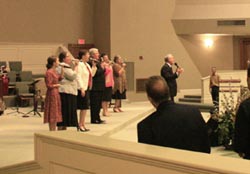
We kind of know what our congregation is a little more drawn to, acceptant of, and we kind of try to stay within something that we know will work for a service. Because again, there are plenty of songs that I love that I listen to, but in my mind, if I'm looking for songs for church service, in my mind I'm listening to it going "Ok, I love this song, but how would this song work in a service?" And sometimes those are the songs that we take and slightly rearrange to make it work for us or for our service. Some of the stuff that's a little on the wilder side, like guitars and things like that, we can take and bring that down a little bit. Put more keys to it, a little less guitar, so it's not that a rock driving kind of sound. So, again, we are sort of particular about the songs, just knowing what will work for our assembly. (Summers 2016)
By having music of various modes, "wilder" or more reflective, the worship leader is tapping into the function of the music in the service.
In a typical Pentecostal service, music played and sung at the start of the service can be described as "Praise" music. It is of a fast tempo and energizing. This is music intended to encourage the congregation to come to worship and focus their attention on the meaning of their weekly gathering. The music shifts into "Worship" styles when it is felt that the congregation has moved to a more personal and direct relationship in their prayer. This shift is marked by slower music tempos, "pull at your heartstrings" music as Deidre describes it. The most important function of the music at that point is to sustain and support the membership in their direct worship. Sometimes, this can take the form of speaking in tongues or being overwhelmed by the power of their direct connection with God. And sometimes, the worship leader can feel that the congregation is moving in that direction before the music has, what Deidre calls "a God moment." Deidre explained what it is like for a music director when that happens:
Well, in the flesh we do the best that we can and we let God take over, honestly, because there are plenty of times when you're going "I'm really feeling this song but man, we didn't practice this song, you know, it's been a while since we did this song, but I'm really feeling this song, so!" So we'll kind of, you know it's one of those things that can only be described as a God moment. If God is telling you to do it and you know in your heart that this is where we need to go, you just make it happen. We have a platform guy that helps with leaps and you're just looking at him "Get this song out the book! Get this song out the book! Get it now! Get it now! I mean, like let's go on!" And everybody's scrambling, trying to rush and media's trying get the words loaded up in there and all that kind of stuff, so I mean, it happens. But I mean we just, we know when it happens that it's a God thing and it needs to happen, so we just make it work! (Summers 2016)
To be that flexible means that the Worship Leader and her musicians need to be in full command of their music. The Praise Team at First Pentecostal prepares each week by listening to the selected songs, sent to them in a Dropbox folder by Deidre, which they download and learn. None of the singers needs to read music and sheet music is not used in rehearsal by the singers. All learning of parts is done by rote and memory.
Deidre understands her role as Worship Leader for the church to be integral to the flow and success of the service. If the music is not moving the congregation into worship, then it is not fulfilling its role. She feels that her role is not just leading the congregation in song, but also leading the Praise Team so that they can help the congregation. The two are tied together in this way:
You're that go-between between the praise singers and that congregation to sometimes pull that congregation to you. And at the same time, you're pulling the Praise Team along with you too, to engage them in that worship. To engage them to, you know, set the atmosphere. Because that's what a Praise Team does, and as a worship leader, I take that very seriously. I'm not up there just to do a job. It's not about the performance. It is literally about a vertical worship. It is about engaging that congregation, bring them in, setting the atmosphere. Because that is what music is for, in the church, is to set the atmosphere for the word of God to come forth and to be preached. And music, you know when it's talked about in the Bible. The Bible talks about David, whenever Saul's heart was hardened, he would call for David to come and play, and that music would help to soften Saul's heart. And I think music, in the church especially, is just the best tool in order to soften people's hearts to be able to receive from the word of God. So as a worship leader, that is my number one goal, is to usher in the presence of God, let my worship and the worship we're trying to bring, to usher in the presence of God to let people's hearts be open so that they can receive what they need to receive from the word of God. (Summers 2016)
In the Pentecostal church, instrumental and vocal music is necessary for moving the spirit in the direction of vertical and personal worship. For other denominations, a cappella vocal music provides the most direct connection for their worship.
Songleaders in the Church of Christ
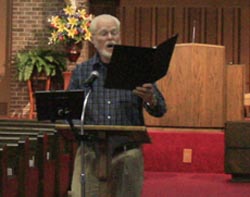
The Goodwood Church of Christ on Goodwood Boulevard holds two services on Sundays. The larger service, featuring a celebration of the Lord's Supper, happens in the morning, while a smaller group gathers in the early evening to sing, pray and reflect on the lesson taught by their minister, Joshua Fowler. The service begins with two hymns, sung a cappella and led by one of the male congregants of the church. The song leader stands at a lectern in the center of the main aisle, towards the back half of the church. Once the song title and number in the hymnal is announced, the congregation heads right into singing, with members choosing their own parts, bass lines, tenor, and alto parts rising up with confidence as the hymn moves from verse to verse. The music and lyrics are projected on the wall beside the altar using a program called "the Paperless Hymnal." Those who read music may notice something curious about the shape of some of the notes. Triangles instead of round note heads, some pointing in one direction, others in the opposite direction, occasionally followed by square notes. These shapes point back to a time when singing was taught within the Church of Christ by shape notes. And while there is no immediate memory of singing schools which taught the shapes at Goodwood, the congregation is familiar with it in a historical sense. What survives instead is active use of harmony singing by the congregation, which the shapes were originally used to help teach. Harmony is still important and present.
When asked about the importance of a cappella singing at Goodwood, the minister there, Joshua Fowler, recalled that singing has been an essential part of the church since its beginnings and that the congregation's approach to music reflects the church's founding:
The Church of Christ is part of a restoration movement. And the whole purpose of the restoration movement is to restore the church as closely as we can in the 21st century to what the First century church was like. One of the things the First century church did was sing a cappella. They probably didn't sing four part harmony, but they didn't use instruments. . . . As a restoration movement, that's one of the things that we have just kind of gone back to. It's a point of contention for a lot of folks, particularly in the a cappella tradition as we see some of our brothers moving away from that, it causes some strife. For me, it's all about heritage. It's a way that anchors me back into those early fathers of the church. And through the years, more recently my father, my grandfather, my great-grandfather that were part of the Churches of Christ and those men that have gone on before that honored that tradition, it's a way for me to connect with that heritage. And it separates what we do in church from a lot of the other music that is in our lives. That's the role that it plays for me and I think for a lot of folks that are in that tradition as well." (Fowler 2016)
The connection between the music of the past or the music in one's past and the present use of music is an important theme in how the congregation relates to the music sung at Goodwood Church of Christ. The majority of the hymns used in the service are very old, some dating back to the mid to late 19th century, with settings of important figures in Protestant hymnody like Isaac Watts, best known for the Christmas hymn, "Joy to the World." A popular hymn sung one Saturday evening service was "Softly and Tenderly," written in 1899 by William Thompson, with another song that evening, "I Come to the Garden Alone" dating back to 1913. The sentiments of the songs still hold deep meaning for the members of the church, no matter their age. Wesley Bradford, a Ph.D. student in Music Theory at LSU, often leads singing at services for Goodwood. He explained that while the bulk of the hymnal used in the Church of Christ does rely on these older hymns, newer hymns and songs are being composed and used in the services. Introducing new materials usually occurs first within youth groups, and then gradually those contemporary songs gain more usage throughout the church as the members grow in familiarity with the songs. Wesley, looking at the difference between newer and older songs, explained it from his perspective as a music theorist:
Sometimes I think that actually the harmony is simpler in some of the newer songs than some of the older songs. And sometimes the rhythm, especially verses what's on the page verses what we sing. A lot of times in the more contemporary songs, [it] is less clear cut. We'll have songs that I think, my own personal theory on what has happened is that, like you said, a lot of people learn them without having the music with them and they'll get really widespread and everybody will know kind of how they go, so to say, and somebody will be like, "Oh, by the way, here's the music for it too." And it doesn't always quite match up with how people know how it goes. And I feel like that's more of a thing with the more contemporary songs. Maybe a change in people not having as much musical education and less likely to read music now. I don't know if that's a statistic or not, but that's just kind of my own ideas." (Bradford 2016)
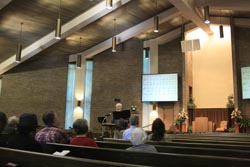
With a tradition rooted in a cappella singing, it makes sense that variations might occur from place to place as to how songs are sung. Still, these differences are seen as regional variations, and uniformity of interpretation is not strictly enforced. The job of the song leader for each church is choose which hymns will be sung at the service they are leading. They might confer with the minister to understand the theme of the lesson for that week, but most often the music is chosen because it is a familiar or favorite song for the song leader to lead. Only men may lead songs, and they agree to serve as one of the many service options available within the church. It is a volunteer position, not a paid church job. Wesley described his process for choosing songs as keeping in mind the flow of the service, choosing songs that move the congregation from one section of the service to the next. He commented:
For me when I'm selecting songs, sometimes we'll already have an idea of what the sermon is going to be about or the lesson is going to be about. Not always, but sometimes. And when I do know that, I try to keep that in mind when I'm selecting my songs and the songs are part of trying to kind of help create the mindset, create the mood. Like on Sunday mornings, we take communion every week and I try to choose songs that have something to do with," I'm trying to think about the cross and Christ or the Lord's s supper itself," And so I try to do that. And usually when I get up there, before the song that comes immediately prior to the communion I usually say something along the lines of "To help prepare ourselves for this element of the worship, we're going to sing this song." And you know, opening songs I try to think of usually something that is a little upbeat and different songs and like songs that, like before the prayer, "Sweet Hour of Prayer," or something to again, kind of help prepare for whatever is coming next. Also from a technical standpoint, again just trying to set some sort of at tempo that ideally people will follow, which is again not always as easy as you might think, a key, help sing the melody for people who might not know it. In most Churches of Christ, the song leaders are the only one who would be mic'd. And so, again that helps with people being able to pick up on the melody and follow even if you are sing the harmonies, to be able to hear relative pitches. (Bradford 2016)
The approach to musical styles and the role of the worship leader at Goodwood contrasted sharply with the other Protestant traditions in this study. Hymns, like at Greater New Guide, are an essential part of the service, and the maintenance of flow is necessary at all three protestant churches, from Pentecostal to Baptist to Church of Christ. However, stripped-down nature of the singing at Goodwood, and the absence of instrumentalists, means that the song leader is solely dependent on the congregation to move the spirit through music. Another shape note singing tradition in Baton Rouge also relies on the group as a whole for singing hymns, but instead in a secular context.
Group Singing: Shape Note Singers and Gospel Quartets
While choirs are typical of many churches in Baton Rouge, there are other kinds of ensembles in which the performance of the music has different functions. In one, Sacred Harp singing, the material has spiritual and religious origins, but the use is not religious. Instead, singing is a tool for building a secular community, one based on love of music. In another, the gospel quartet mirrors the function of the gospel choir, but it is condensed to a small group of voices, still powerfully connecting their worship to that of their church's appreciative membership.
The Baton Rouge Shape Note Singers
On the fourth Sunday of nearly every month, a group of singers gathers at the St. Albans Chapel on the Louisiana State University campus to sing old hymns in the Shape Note tradition. The style of singing gets its name from the fact that like the hymnal found at Goodwood Church of Christ, the hymns are written in a musical notation of shapes, triangles, squares, and circles. While the hymns are certainly sacred in their content, the context of the singing is secular. The gathering of singers is strictly for the love of the music.
A singing session starts with the room set up in a square. The chairs are placed in rows along the four sides of a square, each side denoting a singing section: treble, alto, tenor, and bass. The center of the square is left empty, and thereby giving the name to the room set-up as the hollow square. Sometimes, a song leader will stand in the center of the square in order to conduct the singing, facing different sections as the song progresses and keeping steady time with their arm. Members choose which songs they will sing during the course of the afternoon, with favorite songs being led by those who choose the song, or by an appointed leader. The song first is sung in "shapes," meaning instead of singing the lyrics, the singers use a system of syllables, one for each note in the scale, called solfege that corresponds to the shapes on the staff. For example a note with a triangle shape would be sung as "fa", a circle as "sol," a square as "la," and diamond shape as "mi." This helps remind the singers of the melody before singing the song proper. Once through a verse with the shapes, the singers sing the next round with the lyrics, often singing all the verses of the song to the end. After several songs, the group might take a break for coffee and visit with friends, before starting again. At the gathering at LSU, two large songbooks are used: a blue book, known as the Cooper edition and a brown book, known as "The Sacred Harp." Both contain many of the same songs, but arrangements may vary, depending on the volumes editor. Occasionally, singers will ask to review their specific part for a song, but often singers learn their parts by listening to their neighbors. Singing loudly, as a result, is highly encouraged!
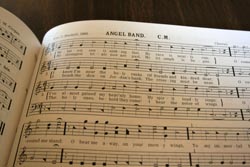
The group in Baton Rouge is relatively new, founded in 2010 as a result of several musical acquaintances wanting to start a singing session like those they had participated in elsewhere in the South. The Sacred Harp tradition of singing is well-known as a religious tradition in parts of Alabama and Georgia, but it is less well-known as a tradition, sacred or secular, in Southern Louisiana. Two of the founders of the Baton Rouge Sacred Harp singers shared their motivations for starting the group. Nanette Olivier is a native of Louisiana, but did not grow up in the Sacred Harp tradition. Neither did the group's co-founder Charlene Heaton, who is a native of Pennsylvania and encountered the tradition of sacred harp while living in Missouri. Both women are first and foremost interested in the singing, the music notation, the old poetry, the musical settings and the community that is created at singing sessions. And while the sessions are secular, they can have spiritual aspects for individual singers. Nanette commented on this:
There's something about referencing this text that others across churches and traditions and belief systems that come together and speak those words and with the melodies and harmonies is just so uplifting and centering, and it's kind of a spiritual experience. For me it is. I think it's the history of everyone who has proceeded you in singing in this tradition, there's something about it. (Olivier and Heaton 2016)
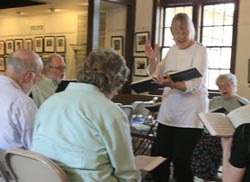
History is very present in these old hymns, several of which have authorship that dates to the 18th century. For example, "Africa," is a well-known shape note song written by American choral composer William Billings sometime in the late 1700s. Billings wrote music to verse by the hymnodist Isaac Watts to create this piece that is still sung by Sacred Harp groups today. In fact, Charlene pointed it out as one of her favorite songs to sing because of how poetically Isaac Watts poses theological questions in the verse:
I love when the text has little surprises in it or really nice language. Like "Africa" I really love because the text says, . . . it says basically, if God is God, then would God be anything less than merciful? But it's said poetically, and it's almost like a rhetorical question at the end. Is God a God or not? And it makes me very excited to read the text and then to put it with the beautiful melody. I just think those two really match well. (Olivier and Heaton 2016)
While the gathering itself is not considered overtly sacred, the meaning behind the texts and the singing of them leads some members of the group to think spiritually about their singing. Nanette explained that the point of the gathering is to sing, and to be inclusive, so that there are no barriers to participation. Making the singing session be about religion might discourage genuinely curious singers, but the members also respect that the Sacred Harp tradition is originally a sacred music tradition. Charlene added that the group does close the singing session with a closing prayer, but refrains from describing the prayer as traditional Christian prayer, instead it is "a thanksgiving for the music, for the text and our coming together." In the end, the singers are gathering out of love for the music, which seems to generate its own spiritual reflection.
“Having a Good Gospel Time”: The Greater St. James Men Singers
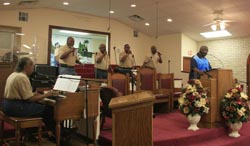
On the same fourth Sunday of the month, a gospel quartet takes center stage at a small Baptist church just up Highland Road from the Sacred Harp sing. The group of five men, wearing matching khaki polo shirts and jeans, stood behind the lectern and each held a microphone. The service begins with a cue from the organist, Leo Perkins, as the congregation gets settled into their places in the pews. The church could probably seat 100 people total and it was packed, with congregation members dressed in their Sunday best and the atmosphere excited to have the quartet singing that Sunday. "Let the church say Amen," Pastor Mack Davis requests as he quiets down the church, "Now this guy behind me on organ is ready. Let's give them the glory." This is the quartet's cue and Leo Perkins starts the organ introduction to "Lord, Hold My Hand, While I Run This Race."
The Greater St. James Men Singers has been singing as a group for nearly 11 years, but many of the members have been singing in this church much longer. In fact, their leader, Leo Perkins, has been musical director at the church for over 50 years. He directs other choirs at the church and plays organ during the service. The group came about when three members of the church's inspirational choir finally convinced Leo that they should have a quartet. As founder Donald Knighten told the story, Leo's response was always "Well, I'll look into it. Now if I go ahead and organize this group, I want you all to act right, you see?" Because I'm kind of fed up with different quartet groups." Donald said that was all they needed to prove to him they could "act right" and be a group. Finally, after a few sessions working on songs, the Greater St. James Men Singers sang at their first performance, which was the deacon of the church's anniversary. Donald explained what happened next:
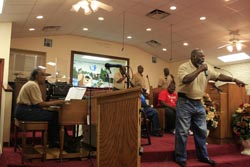
We done one song on the Deacon's anniversary and all the church liked it and wanted to know when we were going to sing again. So we told them, it wouldn't be right then because we had to rehearse some more songs. We were just doing that song to see how we was going to sound and if we sounded ok then we would try to do something else. So that's really how we got our feet on the ground and how we got rolling. We've been rolling ever since then. Back then, we added a member. He went to Beulah Baptist Church, that's around the corner from here on Port Street. And after that we got a drummer. The Lord blessed us with a drummer and his name is Benny Robinson. And our other two members are Richard Kirk and Anthony Joseph. And that's pretty much how we got started. And we're still singing for Jesus and trying to uplift his holy name as much as we can through songs and praise. (Knighten and Perkins 2016)
The group takes its inspiration from the classic gospel quartets of the mid-20th century, groups like the Swan Silvertones, the Clouds of Joy and more recent groups like the Alabama Spirituals. The songs chosen to sing are well-known to all the singers and the congregation, as evidenced by their enthusiastic response at the Sunday service. Leo even writes new repertoire for the quartet and hopes that they will be able to soon make a record of their new compositions.
On Tuesday nights, they gather at the church to rehearse their ever growing song list, which is an actual list of song titles on a piece of yellow legal paper housed in a plastic sleeve. They might go through up to six or seven songs in one rehearsal. When asked how they learn the different parts, Leo responded:
There's a song that we might do that we need to kind of find out where that part goes or where that is, or something like that. But most of these guys, we'll do strictly Gospel beats and every now and then somebody might go in the wrong part or something like that, but we don't usually have. . . . Like I've said, most of these guys have been singing choir songs. The choir and quartet parts are the same. It don't make any difference what you do. If you do choral songs or you do quartet songs, or any time you get a group together, and you teach parts. Well, the parts have got to be the same. Parts don't change, you know. That's why I'm saying quartet, it's just what you're singing. But the parts are not going to change. (Knighten and Perkins 2016)
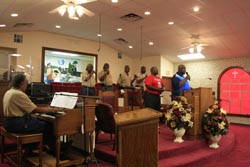
Since all the members came out of the church's other choir, they already had their part assignments and were familiar with the quartet repertoire just by being admirers of the music for most of their lives. One member, Richard Kirk, even sang in a traveling quartet called the Jerusalem Gospel Singers in the near twilight of the genre's popularity, in the late 1960s and early 1970s. They would travel within Louisiana, other nearby states and as far as Detroit and Cleveland, to do church anniversaries or shows. Those gospel show circuits still survive today and the tradition of singing for quartet anniversaries is also still strong in Baton Rouge. For the Greater Saint James Singers 2016 anniversary, they have already booked a neighboring quartet to come sing for them. And if anyone wants to book their quartet, Richard Kirk explains the process:
All somebody has to do is call him [Leo] or Donald or anybody in the group and we just get the word to the right person and go from there. If we come here, we just let each other know what it going on, like for the weekend or the next weekend, and we just get ready to show up and we go do our thing. Have a good time. That's what we call it. Having a good Gospel time. And that's what we try to do. (Knighten and Perkins 2016)
Instruments in Religious Services
Sacred sounds are not restricted to the voice, as instruments can often play a similar role to singing in religious services. The flute, in particular, lends itself to easy comparison with the voice. Both use breath to propel sound into music. Those who play the flute often refer to the instrument's "voice," for the expressive sound produced by an instrumentalist. And in some cultures, the flute appears in folktales and stories as a symbol of communication and magical protection. Unlike an Islamic service at a mosque, the Islamic mystic tradition of Sufism places a priority on music in their religious services and in particular, a reed flute called the ney.
Playing the Ney: Sufi Sacred Music
Kazim Sekerouglu is in his final year as a Ph.D. student in electrical engineering at Louisiana State University and is also a master student of the ney, a reed flute used in Sufi Islam sacred rituals. As a native of Turkey, Kazim takes particular pride in the ney and its repertoire, which he practices when he is not conducting dissertation research. He recalls it was during a visit with another student, his good friend back in Turkey, to his hometown of Sivas that Kazim first became interested in the ney:
I took him to some historical place and there was some music playing there, and it was ney. And I knew it. But at that time, because of the atmosphere or something, it really affected me deeply. And I went to one of the officers that was working in that place and I told him, "What is the CD? Who is playing, this one?" And he was so generous and he told me, "You know what? You can't find this in Sivas. We found it in Istanbul city. But we have two copies of it. I could give you one of them." I was like, wow that's awesome! [He] just handed it over, so I took it. Then, I travel with my friend from Sivas to Ankara, with train it took eleven hours. So those eleven hours, I listened to the CD. There were eleven different songs in it. It was instrumental, so for almost eleven hours I listened with my CD player. Then right after that, I talked to my friend. He's from Adana. (1) The ney is made from a reed. . . . So those south region of Turkey, there are a lot of reed grown so those people, they know more about ney. So I told, "Do you have any friends that can find me a ney?" He told me, "Yes, I have one, actually." So he asked his friend's family and they sent a ney from Adana to Ankara.
The next challenge for Kazim was to find a teacher. In the Sufi tradition of learning, it is considered best to learn not from books or general group classes. The best learning happens one on one, being trained by a great player. Kazim was lucky to find Ikram Bural, an elderly government worker who in his native Turkey was considered a master musician of the ney. To learn the instrument is also to commit to it, as it takes years of direct mentorship to gain all the knowledge necessary for playing the repertoire.
Kazim spent many years working with his master teacher, all the while continuing his studies in engineering. However, when he moved to Baton Rouge to complete his Ph.D. studies, it became more difficult to maintain the close lesson habit he had developed with his master teacher back in Turkey. Kazim explained that while he did try to do online lessons with his mentor, it just did not work as well as being present with his teacher. So, he began studying by himself, seeking out ways to learn from different sources. He explained the process:
So when I came to the United States, I brought my ney with me as I do wherever I go. So I tried doing it by myself, some online courses but it didn't really work. Then I thought, I may not be really qualified to teach but one way of improving yourself is teaching. So I started teaching ney. I have two or three friends. So we gather at least a week, every week, we are playing together. So I try to teach them how to play" (Sekerouglou 2016).
Some of the repertoire that Kazim and his students play comes from the Sufi tradition, a devotional music that is used in sacred mystical rites of Sufi Islam. One such sect of Sufism in Turkey is the Mevlevi sect, also known as the Whirling Dervishes. The music set used for a Whirling Dervish ceremony (also known as a Mevlevi sema) is called an âyin. The ney is one of the most important instruments in any Mevlevi âyin. As Kazim describes, the ney player is called the neyzzin, and the leader of the ney players is called the neyzzin basher which is also the name of the director of the whole ensemble. A group may also include instruments like a kundun, tambour, kanun, and oud. So far, in Baton Rouge, he has not encountered other musicians who play the instruments found in a Sufi ensemble. And so, he's concentrated his efforts on developing his own skill on the ney.
The centrality of the ney to the Sufi repertoire finds its expression in its origin story. The Sufi mystic poet, Rumi, in his epic poem in six books, called The Masnavi, tells the story of the ney at the very beginning of the poem. Kazim shared one version of the origin story that he had heard:
The Prophet had a secret and he told that secret to one of his close friends and his follower and his cousin. Then told them "This is a secret! Don't tell anyone!" So, that secret was too heavy and screamed it to the ditch-place. And then the reed grew from the ditch, and one person took that reed and made the instrument and played that one. And one prophet was passing through when he was playing and he said, that instrument, the sound come from that instrument. "That's the secret of what I told you" (Sekerouglou 2016).
The mystical healing power of the music is also embedded in the theoretical systems that are used to compose the music. In his research into ney repertoire, Kazim came across a book which relates specific musical modes, called makams in Sufi music, to healing properties. For example, if someone has heart disease, they should listen to music based in a specific makam, in this case, the Uşşak makam. This healing interpretation of music even found its way into the medical system of medieval Turkey. Kazim shared that in the 14th century, in his hometown of Sivas, there was a hospital in which the ney was used to alleviate people of mental health problems. The power of the music to enable healing seems to be an ancient trait.
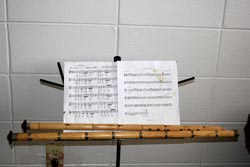
Another term for the music used in the Mevlevi ceremony, which Kazim plays, is the Rumi âyin, a progressive musical set in which the music propels the whirling dervishes into a state of prayerful ecstasy. The head neyzzin plays an important role in the âyin, as he would first play an improvisation, or taksim, on the selected makam. This would set the mood for the âyin. As the musicians go through the various stages of the âyin, the atmosphere becomes more and more conducive for the whirling dervishes to attain a state of ecstasy. When asked if he grew up going to these performances in Turkey, he said it was only in college that he went, but he noted the effect of tourism on the tradition:
If you look at the history, it is done every day in a dergah, where those dervishes were coming together and they might be living together. But after that . . . during the 19th and 20th century, it becomes more touristic. Now, those dervishes are all over the world. They do that everywhere, every time, you know. There is no certain time and place now.
Today, in Turkey, attitudes toward the ney are a bit more modern. The ney will be heard most prominently around Ramadan, and is even a key feature in certain television show's theme music and in film. One of the pieces that Kazim plays in particular is from a well-known Turkish film. And so the repertoire is not restricted to religious venues. It would not be unusual to find female ney players, and there are even neys specifically made for female players. However, religious music is still played only by men.
At his home in Baton Rouge, Kazim has a collection of neys, each of which produces a different kind of tone depending on the length of the instrument. Back in Turkey, there are at least 10 different sizes of ney, but what they all have in common is that the reed used to fashion the ney must have nine segments and be straight. That is why finding the perfect reed is so important. One of the things that Kazim has decided to do before he returns to Turkey is make a pilgrimage to see the oldest ney in existence, which is in a museum collection at Pennsylvania State University. As someone who has such a love for the instrument, he understands the commitment it takes to play and practice, but also sees the benefit of playing, "it requires really hard working. I know a person who was playing seven, eight hours every day, so it's not easy. Being a PhD student in another field, yeah but it's pretty good when you have stress or anger or anything, just blow out, just take them go out from you."
Conclusion
Music and song have a central but sometimes conflicting position within religious faiths, as seen in this project. The Biblical story of Lucifer being cast of our heaven while also being God's choir director was often given as an example for how potentially distracting music can become to the mission of a faith community. In other denominations, the word music was not an adequate term for describing how prayer and sacred language is employed in their worship service and daily lives. Still, the singing of sacred texts and prayerful language is an important method for delivering a holy message, whether that be communication of God's words or communication with God. Common to all the communities documented was the importance of the institution for maintaining and guarding musical traditions. Almost all the communities in this project were part of a specific institution, whether church, mosque, or synagogue, and in the case of the Shape Note community, on-line connections with other singing groups. Through these institutions, rules are set as to how music (or recitation) will be employed in the worship service, discussions are had about the need for shaping new rules, and community members find outlets for participation.
Notes
1. Adana is a southern province is Turkey, and is bordered by the Mediterranean Sea to the south.
Sources
Bradford, Wesley. 2016. Interview with the author. March 21. Goodwood Church of Christ, Baton Rouge.
Fowler, Josh. 2016. Interview with the author. April 22. Goodwood Church of Christ of Baton Rouge.
Knighten, Donald and Leo Perkins. 2016. Interview with the author. April 27. Greater St James Baptist Church of Baton Rouge.
Lacraru, Emanuela and Jaycob Warful. 2016. Interview with the author. March 20. Holy Trinity Greek Orthodox Church of Baton Rouge.
Monteleone, Anthony. 2016. Interview with the author. March 29. Holy Trinity Greek Orthodox Church of Baton Rouge.
Olivier, Nanette and Charlene Heaton. 2016. Interview with the author. April 28. Baton Rouge Sacred Harp Singers.
Quang, Thich Dao. 2016. Interview with the author. April 2. Tam Bao Meditation Temple, Baton Rouge.
Rice. Antonio. 2016. Interview with the author. March 17. Greater New Guide Baptist Church, Baton Rouge.
Rushing, Stephen. 2016. Interview with the author. March 11. B'nai Israel Synagogue, Baton Rouge
Sekerouglou, Kazim. 2016. Interview with author. March 7. Baton Rouge.
Soysal, Ömer, Suleiman Suleiman, Nafes Hakim-Khiry Furqan, Muhammad Abelussalam, and Hanif Soysal. 2016. Interview with the author. February 27. Masjid Al-Rahman campus, Islamic Center of Baton Rouge.
Summers, Deidre. 2016. Interview with the author. March 22. First Pentecostal Church of Baton Rouge.
Van, Fred. 2016. Interview with the author. April 11. Tam Bao Meditation Temple, Baton Rouge.
Webster, Pastor Isaiah. 2016. Interview with the author. April 4. Greater New Guide Baptist Church of Baton Rouge.



